For homeowners, the discovery of a wasp nest can be a daunting and unsettling experience. The presence of these buzzing insects can quickly turn a peaceful backyard into an unwelcome territory. However, knowledge is power, and understanding the behavior and habits of wasps, as well as learning effective prevention and management strategies, can empower homeowners to confidently navigate the world of wasp nests. In this blog post, we aim to provide you with essential information, practical tips, and expert advice to help you handle the challenges associated with wasp nests, ensuring the safety of your home and loved ones.
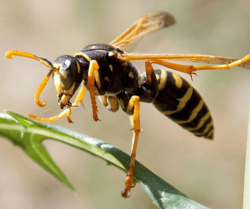 European Paper Wasp on plant
European Paper Wasp on plant
Wasp Biology and Behavior
Contrary to popular belief, not all wasps are the same. In fact, they belong to the order Hymenoptera, which encompasses a vast array of species, each with its own unique characteristics and ecological niche. From the familiar yellowjackets and paper wasps to the lesser-known mud daubers and parasitic wasps, these insects exhibit a stunning diversity of forms and behaviors.
One of the most intriguing aspects of wasp biology is its social structure. Unlike solitary wasps, which live and hunt independently, social wasps form complex colonies. Within these colonies, various castes, including queens, workers, and drones, work together harmoniously to ensure the survival and success of the nest. We'll explore the intricacies of their social hierarchy and the fascinating process of nest construction, observing how these diligent architects create their papery abodes.
Wasps are not just skilled builders; they are also exceptional hunters. Equipped with sharp mandibles and a venomous sting, they employ an array of hunting techniques to capture prey, ranging from other insects to spiders and even small vertebrates. From ambush predators to scavengers and parasitoids, wasps have perfected a diverse set of strategies to procure food for themselves and their colonies.
Beyond their pest control services, wasps contribute significantly to our ecosystem. By pollinating flowers and plants as they search for nectar, they aid in the reproduction of various species, ensuring the continuity of biodiversity. Additionally, certain species of wasps are indispensable as biological control agents, preying on agricultural pests and helping maintain the delicate balance of our crops.
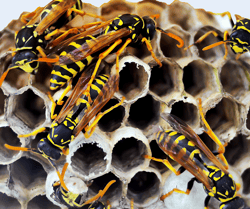 Wasp colony in nest
Wasp colony in nest
Where do wasps live?
Wasps can be found throughout the United States, as they are widely distributed across the country. The specific species and their preferred habitats may vary depending on the region and local environmental conditions. However, it's important to note that the general habitat preferences of wasps include areas with access to food sources, such as gardens, orchards, and flowering plants.
In urban and suburban areas, common wasp species like yellowjackets and paper wasps can often be found nesting in residential areas, building their nests in sheltered locations such as eaves, attics, trees, shrubs, or even underground. They may also take advantage of human-made structures like sheds, garages, and abandoned buildings.
In more rural or natural settings, you may encounter different species of wasps, including mud daubers, hornets, and solitary wasps. Mud daubers, for instance, construct their nests from mud and are often found near water sources or in outdoor structures like barns, sheds, or under bridges. Hornets, known for their large nests, can be found in wooded areas, forests, or near trees.
It's worth noting that while wasps are adaptable and can inhabit a wide range of environments, their nest locations and distribution can vary based on factors such as climate, vegetation, and availability of suitable nesting sites. Therefore, the specific regions and habitats where wasps are found in the United States can vary from state to state and even within different parts of the same state.
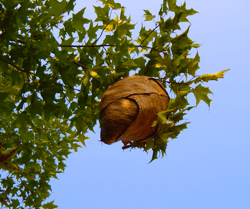 Hornets, known for their large nests, can be found in wooded areas, forests, or near trees.
Hornets, known for their large nests, can be found in wooded areas, forests, or near trees.
Wasp Nests Based on Species
When it comes to building homes, wasps are master architects. These industrious insects construct a wide range of nest types, each exhibiting its unique structure and design. From delicate papery abodes to intricate mud dwellings, the diversity of wasp nests is a testament to the ingenuity and adaptability of wasps.
What do paper wasp nests look like?
Paper wasps are known for their delicate, papery nests that are often suspended from branches, eaves, or other protected areas. Constructed by chewing and mixing plant fibers with their saliva, these nests typically have an umbrella-like shape with open cells. The layers of the nest provide additional protection and insulation for the developing wasp larvae. Paper wasp nests can vary in size, ranging from a few inches in diameter to larger structures housing hundreds of individuals.
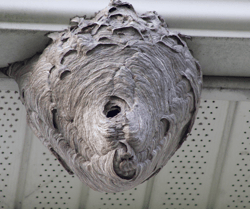 Paper wasp nest
Paper wasp nest
What do yellowjacket nests look like?
Yellowjackets, often associated with picnics and outdoor gatherings, build nests in hidden or underground locations. Their nests are made from chewed wood fibers mixed with saliva, giving them a papery texture similar to paper wasp nests. However, yellowjacket nests tend to be enclosed, with a single entrance. They can be found in various places, such as abandoned rodent burrows, wall voids, or tree hollows. As the colony grows, so does the nest, eventually accommodating thousands of wasps.
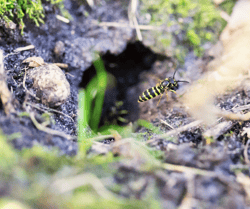 Yellowjacket nest
Yellowjacket nest
What do mud dauber nests look like?
Mud daubers are solitary wasps that construct unique nests using mud. They gather mud from puddles, moist soil, or even the edges of water bodies. These nests are often tubular or elongated in shape and are commonly found on walls, rocks, or under eaves. Each mud dauber nest consists of multiple chambers, with each chamber housing a single egg and a paralyzed prey item as food for the developing wasp larvae.
.png?width=250&height=210&name=Mud%20Dauber%20Nest%20(1).png) Mud dauber nest
Mud dauber nest
What do hornet nests look like?
Hornets are known for their large, distinctive nests that can be found in trees, shrubs, or other elevated locations. These nests are constructed using chewed wood fibers mixed with saliva, similar to yellowjacket nests. However, hornet nests are much larger and can house hundreds to thousands of individuals. The nests often have a spherical or teardrop shape and feature multiple layers and combs where the wasps reside.
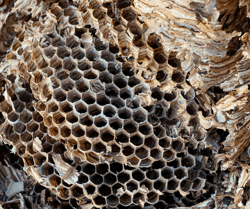 Inside hornet nest
Inside hornet nest
What do solitary wasp nests look like?
Solitary wasps, as the name suggests, do not live in colonies and each female wasp constructs her individual nest. The nesting habits and nest structures of solitary wasps vary greatly depending on the species. Some build nests in the ground, digging burrows or tunnels, while others use pre-existing cavities, such as hollow plant stems or abandoned insect burrows. Solitary wasp nests can range from simple burrows to complex structures with separate chambers for each egg.
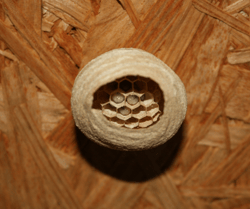 Solitary wasp nest
Solitary wasp nest
What should I do if there is a wasp nest on my property?
Discovering a wasp nest on your property can be a cause for concern and potential danger. When faced with this situation, it is crucial to seek professional assistance to ensure the safe removal of the nest and the effective management of the wasp population. At EcoShield Pest Solutions, we are dedicated to providing reliable and comprehensive pest control services, including expert wasp nest removal.
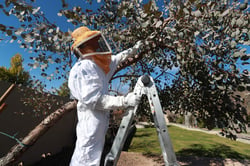 EcoShield technician in required safety gear while inspecting tree for signs of stinging insects.
EcoShield technician in required safety gear while inspecting tree for signs of stinging insects.
Why should I choose EcoShield for wasp & wasp nest removal?
The EcoShield Pest Solutions team of highly trained and experienced pest control professionals specialize in wasp nest removal wherever the nest may be. Our technicians have a deep understanding of wasp behavior, nest structures, and effective removal techniques. With their expertise, they can assess the situation, determine the appropriate approach, and execute safe and efficient removal procedures.
In addition, attempting to remove a wasp nest without proper knowledge and equipment can be extremely risky. Wasps are protective of their nests and can become aggressive when threatened, posing a danger to you, your family, and even your pets. At EcoShield Pest Solutions, we prioritize safety above all else. Our technicians are equipped with the necessary protective gear and utilize proven methods to minimize the risk of stings and ensure a safe environment during the nest removal process.
Every wasp nest situation is unique, and a one-size-fits-all approach may not yield satisfactory results. At EcoShield Pest Solutions, we understand this and provide tailored solutions to address your specific needs. Our experts will conduct a thorough assessment of the nest, considering factors such as nest location, species involved, and the level of infestation. Based on this evaluation, we will develop a customized plan to safely remove the nest, eradicate the wasp population, and implement preventive measures to minimize future recurrences.
We believe in responsible pest control practices that prioritize the well-being of both our customers and the environment. EcoShield Pest Solutions utilizes eco-friendly products and methods that effectively eliminate wasp nests while minimizing any negative impact on the surrounding ecosystem. Our commitment to environmental sustainability ensures that you receive effective pest control solutions without compromising the natural balance of your surroundings.
When it comes to the safe and efficient removal of wasp nests, EcoShield Pest Solutions stands as your reliable partner. With our experienced technicians, commitment to safety, customized solutions, eco-friendly practices, and ongoing support, we offer a comprehensive approach to tackling your wasp nest problem. By choosing EcoShield Pest Solutions, you can trust that your wasp infestation will be effectively addressed, ensuring your safety, peace of mind, and a wasp-free environment for you and your loved ones.
Give us a call or fill out the form on this page today for your free no-obligation quote!